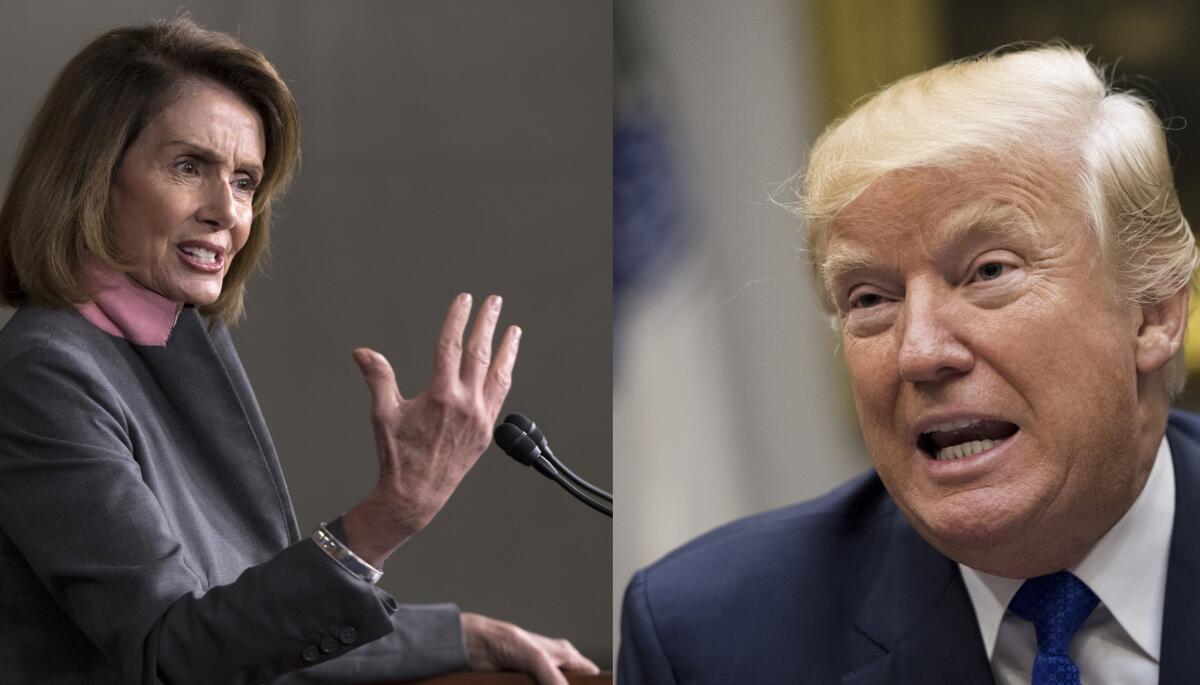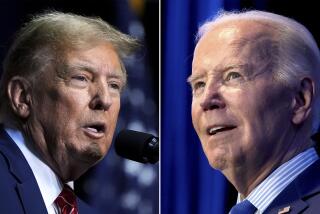In a highly partisan era, those who dislike both sides could have the deciding votes

In this and every election, both sides devote huge resources to getting their partisans to turn out and vote — “motivating the base,” in the jargon of politics.
But in many close races in California and around the country, a different group, those who don’t like either party or its leaders, could hold the decisive votes.
The “hold your nose and vote” brigade makes up a sizable chunk of the electorate, according to the latest USC Dornsife/Los Angeles Times poll. With election day just over a week away, the poll indicates they lean toward the Democrats. That’s one reason Democrats remain favored to win back control of the House.
Overall, this latest poll, conducted last week, finds Democrats leading 57% to 40% when likely voters were asked for which party’s candidates they plan to vote, a 17-point edge.
That’s a notable increase in Democratic support from the previous week, when the poll found Democrats with a 13-point advantage. The increase, which stemmed from small shifts among several groups of voters, may partly reflect timing. The final two days of the poll coincided with the arrest on Friday of a Florida man on charges of sending explosive devices to prominent Democrats and critics of President Trump, and the killing on Saturday of 11 people at a synagogue in Pittsburgh.
In a tweet on Friday, Trump expressed concern that news coverage of the mail bombs might hurt Republicans. Whether either of those events might have a lasting effect on the election is anyone’s guess. So far this year, however, news events have not had a large or long-term impact.
A second measure in the poll that factors in voters’ estimates of how likely they are to cast a ballot also shows Democrats ahead by a narrower 52% to 42%.
In 2016, the same poll consistently showed then-candidate Trump winning. It skewed toward the Republicans by a few percentage points in its estimate of the final vote.
Get the latest news from the nation’s capital on Essential Washington >> »
Analysis of individual races shows Republicans continue to hold the edge in contests for the Senate, most of which are being fought this year in conservative states.
Five Senate races are heading into the final week as toss-ups, polls indicate: Arizona and Nevada, in which Democrats hope to win seats currently held by Republicans, and Missouri, Indiana and Florida, in which Republicans hope to defeat Democratic incumbents.
Republicans have a strong chance of defeating Sen. Heidi Heitkamp, the Democratic incumbent in North Dakota.
In the House, Democrats need to net 23 additional seats to win a majority. They appeared to have about 17 pickups fairly well in hand going into the final week of campaigning, according to polls and nonpartisan assessments by those who track congressional races.
Whether the Democrats will get to their goal or Republicans hold on to their majority will depend largely on the outcome of more than 20 toss-up races, including at least three in Southern California. Almost all of those contests involve districts Republicans currently hold.
Republican officials, at least publicly, forecast an outcome very close to an even split.
“No matter who takes the majority, it will be a razor-thin majority,” Rep. Steve Stivers of Ohio, the Republican campaign chief, said Sunday on NBC’s “Meet the Press.”
Democrats, by contrast, hope that voter enthusiasm on their side, reflected in part in a torrent of small donations to their campaigns, will push many of the closest contests their way and generate enough upsets to bring about a larger majority for their party.
They’re on track to significantly outspend the Republicans in many close contests, campaign disclosure reports show, thanks in part to last-minute infusions of cash from some big donors.
The USC Dornsife/Los Angeles Times poll continues to show roughly equal levels of interest in the election on both sides. That’s an encouraging sign for Democrats, whose voters have lagged significantly in the last two midterm elections. Just under 4 in 10 Democrats and Republicans said they were paying “very close” or “extremely close” attention to the campaign.
See the results of the most recent USC Dornsife/Los Angeles Times polls »
But with the two sides closely balanced, the outcome in many races could depend on voters who don’t easily fit with either party.
The poll offers two ways to examine the views of voters who disdain both sides. One simply looks at their views of the party leaders.
Likely voters disapproved of Trump’s performance in office by 57% to 41%, the poll found. That 16-point gap remains historically bad for a president in a time of strong economic growth.
Rep. Nancy Pelosi of San Francisco, the House Democratic leader, is less well known but fared no better among voters with an opinion. Likely voters disapproved of her by 49% to 32%, with 19% unsure.
In both cases, a strong partisan gap shaped those approval numbers. In Pelosi’s case, gender played a strong role, as well: Even after taking party into account, men disapproved of her significantly more than women.
Roughly 1 in 6 likely voters disapproved of both. When asked which party’s candidate they plan to vote for, that group overwhelmingly favored the Democrats.
That’s the reverse of what took place two years ago.
In the presidential election, slightly more than 1 in 6 voters said they disliked both Hillary Clinton and Trump. Clinton campaign strategists hoped to win over many of those voters by constantly reminding them of aspects of Trump’s behavior that they disliked. In the end, however, those voters heavily favored Trump, according to exit polls.
That shouldn’t have come as a surprise, say political scientists John Sides of George Washington University, Lynn Vavreck of UCLA and Michael Tesler of UC Irvine. In their new book examining the 2016 election, “Identity Crisis,” they noted that those “double negative” voters were disproportionately Republicans.
“They appeared to be holding their nose and voting their partisanship,” they wrote.
That’s not the case this time: The “double negative” voters now — those who disapprove of both Trump and Pelosi — are more likely to have been Clinton voters in 2016.
In addition to asking about Pelosi and Trump, the USC Dornsife/Los Angeles Times poll also asked people to react to some of what each side says about the other in its campaign attacks.
Republicans contend that the Democrats, if they get a majority, will try to enact a “liberal Nancy Pelosi agenda of higher taxes, greatly increased government spending and large defense budget cuts,” the poll told respondents.
Democrats say the Republican Party, if it keeps the majority, will try to enact a “conservative Donald Trump agenda of Medicare and Medicaid cuts, as well as tax breaks for the rich, and they will end affordable health insurance access for people with preexisting conditions.”
Those statements don’t cover every issue in the campaign, of course, but they reflect several of the main arguments used in ads in swing districts, in which Democrats have focused heavily on healthcare and Republicans have warned of higher taxes.
Trump has talked much more about immigration, an issue that motivates many of his core supporters. He’s stuck mostly to campaigning in conservative states with close Senate races, however, avoiding most swing districts, where Republican strategists think he might hurt more than help.
More than 9 in 10 likely voters said they thought it at least “somewhat likely” that each party would try to enact an agenda of the sort described if it had the chance.
Almost half called it “very likely” that Republicans would seek to enact the “Trump agenda” that was described, and about 3 in 10 said Democrats were “very likely” to push the “Pelosi agenda.”
The fact that voters found both agendas plausible “indicates that the Republicans have not broken through” with their counterargument on healthcare, said Robert Shrum, a longtime Democratic strategist and the co-director of USC’s Center for the Political Future, which co-sponsored the poll.
“They’re all saying, ‘I want to protect preexisting conditions too.’ I don’t think they’re getting traction on that, based on these numbers,” he said.
Likely voters opposed the suggested Pelosi agenda 55% to 23% and the Trump agenda 70% to 16%, the poll found.
Almost 1 in 5 likely voters opposed both, and they split closely on which they disliked more. But by 59% to 34%, they said they expected to support Democrats for Congress this year.
Unlike 2016, when the voters who disliked both candidates were disproportionately Republican, those who said they disapproved of both of the agendas described in the poll were more often women and tended to identify as independents, the poll found.
This USC Dornsife/Los Angeles Times poll, supervised by poll director Jill Darling, was conducted Oct. 21 to 27 among 3,922 adult Americans, including 3,453 registered voters, of whom 2,350 were considered likely to vote and 577 said they already had voted early.
Respondents were drawn from a probability-based panel maintained by USC’s Center for Economic and Social Research for its Understanding America Study. Responses were weighted to accurately reflect known demographics of the U.S. population. The margin of error is 2 percentage points in either direction. A full description of the methodology, poll questions and data, and additional information about the poll are posted on the USC website.
For more on Politics and Policy, follow me @DavidLauter
More to Read
Get the L.A. Times Politics newsletter
Deeply reported insights into legislation, politics and policy from Sacramento, Washington and beyond. In your inbox three times per week.
You may occasionally receive promotional content from the Los Angeles Times.







